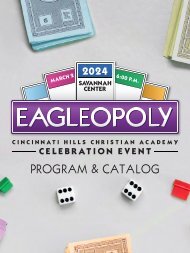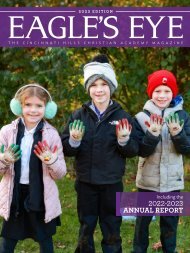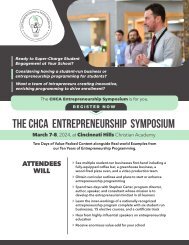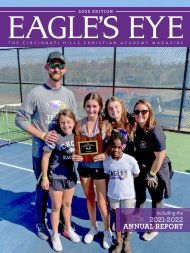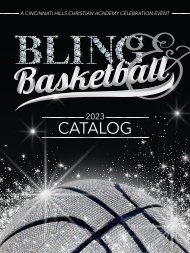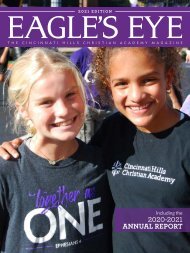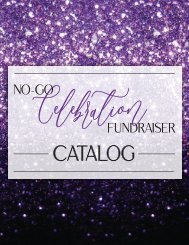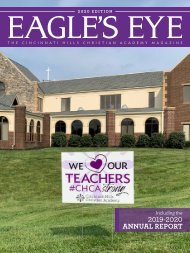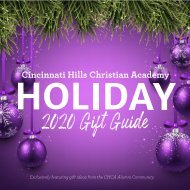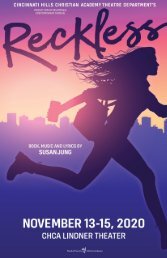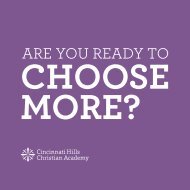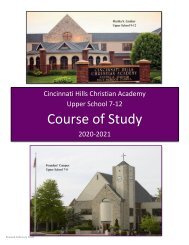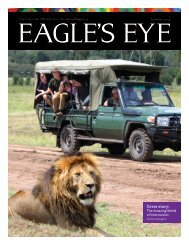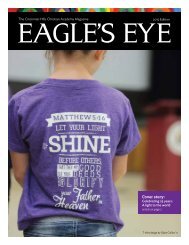Mission, Vision, Competencies, Standards, and Benchmarks
A Statement of Curriculum CINCINNATI HILLS CHRISTIAN ACADEMY Edyth B. Lindner Campus Otto Armleder Memorial Education Center Founders’ Campus Martha S. Lindner Campus 2019 Edition
A Statement of Curriculum
CINCINNATI HILLS CHRISTIAN ACADEMY
Edyth B. Lindner Campus
Otto Armleder Memorial Education Center
Founders’ Campus
Martha S. Lindner Campus
2019 Edition
You also want an ePaper? Increase the reach of your titles
YUMPU automatically turns print PDFs into web optimized ePapers that Google loves.
‣ How do I know which ideas are “right?” What is my criteria?<br />
‣ What does it mean to listen to other people? How is this different from “hearing?”<br />
o What are the benefits <strong>and</strong> limitations of online communication? How is “listening”<br />
to people in an online forum or a social media app different than in a face-to-face<br />
conversation?<br />
Core Underst<strong>and</strong>ings:<br />
Students will underst<strong>and</strong> that…<br />
‣ The message is influenced by the medium; good ideas can be overlooked or dismissed<br />
on the basis of how they are presented.<br />
‣ Knowing when to consult an “expert” can be the difference between good <strong>and</strong> great work.<br />
‣ Changing one’s mind in the face of better evidence is a mark of learning <strong>and</strong> growth.<br />
‣ It is possible to hear without truly listening. Good listening involves engagement with the<br />
speaker’s message…<strong>and</strong> accurately interpreting what the speaker is saying <strong>and</strong> how the<br />
speaker is saying it.<br />
Competency: Information <strong>and</strong> Media Fluency<br />
Description: Students will work to master…<br />
‣ Confidently navigating st<strong>and</strong>ard conventions <strong>and</strong> tools for organizing print <strong>and</strong> digital<br />
resources.<br />
‣ Using inquiry-based research processes by applying critical thinking skills such as<br />
analysis, synthesis, evaluation, <strong>and</strong> organization to construct new underst<strong>and</strong>ings,<br />
drawing conclusions <strong>and</strong> creating new knowledge.<br />
‣ Finding, evaluating, <strong>and</strong> selecting appropriate sources to answer questions <strong>and</strong> to meet<br />
personal learning needs.<br />
‣ Using technology <strong>and</strong> other information tools to organize <strong>and</strong> display knowledge <strong>and</strong><br />
underst<strong>and</strong>ing in ways others can view, use, <strong>and</strong> assess.<br />
‣ Evaluating the accuracy, authority, objectivity, currency, coverage <strong>and</strong> relevance of<br />
information <strong>and</strong> data sources.<br />
Essential Questions:<br />
‣ What sources are most useful for discovering more about my topic? What evidence am I<br />
missing? Where can I go to find the missing pieces?<br />
‣ What makes a written or online resource reliable? What makes it relevant for what we're<br />
studying?<br />
‣ How do we know which sources are most accurate when sources disagree?<br />
Core Underst<strong>and</strong>ings:<br />
Students will underst<strong>and</strong> that…<br />
‣ Some sources, whether documents, media, web pages, or artifacts, are more useful than<br />
others for discovering accurate <strong>and</strong> useful information.<br />
Back to Table of Contents




